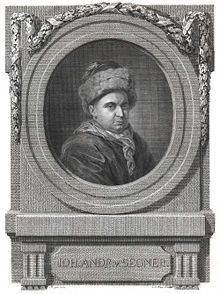Institutions JenaGottingenHalle Role Scientist Fields Mathematics | Nationality Hungarian Doctoral students Johann Georg Busch Name Johann Segner Notable students Johann Georg Busch | |
 | ||
Doctoral advisor Georg Erhard Hamberger, Simon Paul Hilscher | ||
Johann Segner (Hungarian: Janos Andras Segner, German: Johann Andreas von Segner, Slovak: Jan Andrej Segner, Latin: Iohannes Andreas de Segner; October 9, 1704 – October 5, 1777) was a Hungarian scientist. He was born in the Kingdom of Hungary, in the former Hungarian capital city of Pozsony (today Bratislava).
Johann Segner's ancestors came from Styria to Pressburg in the Kingdom of Hungary; by the 18th century. He studied at Pressburg, Gyor and Debrecen. In 1725 Segner began studying at the University of Jena. In 1729 he received a medical certificate and returned to Pressburg, where he started to work as a physician, as well as in Debrecen. In 1732 he returned to Jena for his master's degree. In 1735 Segner became the first professor of mathematics, a position created for him, at the University of Gottingen. In 1755 he became a professor at Halle, where he established an observatory.
One of the best-known scientists of his age, Segner was a member of the academies of Berlin, London, and Saint Petersburg. According to Mathematics Genealogy Project, as of February 2013, he has over 66 thousand academic descendants, out of the total 170 thousand mathematicians in the database.
He was the first scientist to use the reactive force of water and constructed the first water-jet, the Segner wheel, which resembles one type of modern lawn sprinkler. Segner, also produced the first proof of Descartes' rule of signs. Historians of science remember him as the father of the water turbine. The lunar crater Segner is named after him, as is asteroid 28878 Segner.
